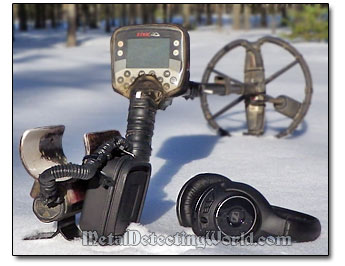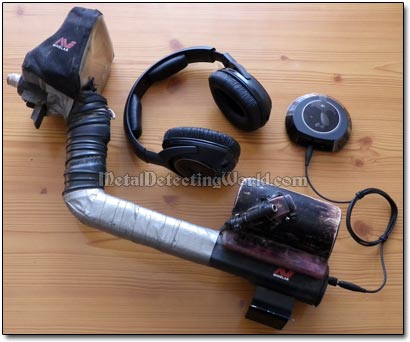How To Make Headphone Operation Wireless
A Simple Solution To Metal Detecting Without Hassle of Headphone Cords, page 1
by Sergei UpstateNY, proficiency level: Beginner, last time modified:
With this setup, you will forget about being tied to your detector, getting entangled with the wire that gets in the way, and having the wire get caught on your shovel!

Introduction
Brief historical facts on development of wireless metal detector operation:
The first wireless headphones for metal detecting appeared on the market in 2005 when the XP Metal Detectors manufacturer introduced the first wireless headset with a transmitter being integrated in the circuit boards of five metal detectors - XP Gold Maxx Power, XP G-Maxx2, XP Adventis 2, XP ADX250 and XP ADX 150. And after users of these detectors got a kick out of metal detecting without being "on a leash", the news spread fast. The XP detectors began gaining their popularity, and a big success followed. One would think that metal detector manufacturers of other major brands would follow suit, but, no, that did not happen until much later.
NOTE 1: This tutorial was created before some manufacturers of metal detectors and accessories began introducing their universal wireless-headphones kits to the market. This wireless-headphone-operation setup consists of regular wireless headphones and a transmitter. Even though this tutorial may seem a little bit outdated, it still gives practical advices for mounting the enclosed wireless transmitter onto the detector's Armrest. If you would like to use a Wireless Headphone Kit designed for any metal detector instead, please see my latest tutorial - The Best Way to Mount A Wireless Transmitter onto Your Metal Detector, which describes a simple $2.50 setup - an compact wireless transmitter is placed into a water-resistant enclosure mounted onto the metal detector's Upper Shaft. The transmitter is water-resistant itself and is part of the kit (transmitter + wireless headphones) specially designed to work with any non-wireless, land metal detector.
In 2009, the XP Metal Detectors company in France introduced a wireless metal detector - XP Deus. Since then the Deus has become unreasonably overcomplicated with annually added new features. And it is too bad because the Deus has been the only fully wireless advanced machine on the market so far (2019-2020).
Because the Deus does not have either a search coil's cable or a headset connecting cord, the digital wireless audio transmission is fast, hence the slightly increased depth penetration. In addition to the Deus' incredible maneuverability and super fast reactivity speed, the wireless detector's operation allows a user to substantially increase the time efficiency in the field, much higher if compared to operation of traditional metal detectors used with the wired headphones.
One would think that with appearance of the Deus other brand md manufacturers would follow suit! Hmm... no... They were busy designing lots of nonessential features such as built-in GPS, various colorful screens ("Edit", "Detect", "Map", "Polar Plot", "Frequency SpectraGraph", etc.), Waterproof (this is a very costly feature and may increase the detector's price by 30%!), "Zoom" ("this makes the text larger or expands a menu" - WHAT?! Is this an electronic book reader or a metal detector?!), Mixed Mode Audio ("All-Metal in one ear, Discrimination in the other" - yeah, when you become deaf in one ear after having used this mode for long, you can switch the ear cups around so that you could still enjoy the All-Metal mode!), and so on! (this list of unnecessary and COSTLY features can be endless)
I am only wondering how soon are they going to incorporate a video game, "Metal Detect For Treasures", into a metal detector? So one could stay home and still treasure hunt! Or, with this game, one would certainly not have time for real metal detecting at the hunt site...
Only in 2012 two major metal detector makers - Minelab and White's, made a little progress in incorporating wireless technology into their latest models, CTX 3030 and Spectra V3i, respectively. They integrated transmitters into their latest detectors to make just the headphone operation wireless. But how about developing and producing similar cheap wireless transmitter modules for older models of metal detectors that still have been popular and in demand?
Not many of the Minelab's die-hard fans can afford a $2,500 fully waterproof detector/GPS unit to enjoy a semi-wireless metal detecting operation. I honestly do not understand why most metal detector manufacturers have not been able to design metal detectors that would respond to wishes, complains and suggestions of real detectorists from around the world? At least one company, the XP Metal Detectors, decided to manufacture a fully wireless metal detector.
Nowadays the up-to-date metal detector must enable its user to get satisfactory metal detecting results even at the heavily pounded hunt sites (90% of metal detecting sites) while maintaining high time efficiency in the field. And the detector's wireless headphone operation plays a major role in the latter. The faster you recover detected targets, the more search area you cover within given time! Back in 2005, effects of this simple approach started being noticeable through metal detecting results that were certainly in favor of the XP GoldMaxx Power metal detectors when compared to results of the fully wired detectors used side by side with the GMP's.
Those enthusiasts who saw advantages in the detector's semi-wireless operation but could not afford to buy a brand new GMP, or did not want to part with detectors they got used to, began experimenting with the wireless headphones and transmitter modules that were available on the market of home and music audio electronics, i.e. they were designed for the indoor usage. Many tried headphones with Bluetooth technology but only a few stayed with it due to an unacceptable signal lag - a time delay in audio sound between a detector, transmitter and the wireless headphones, that is associated with the Bluetooth technology. If you were a reasonably fast search-coil swinger, then using these headphones would be a bad joke for you because you would be a foot past the target before you get a response to it. And most of the Bluetooth devices are known for being jammed by radio sources likely to be nearby.
Some detectorists attached various guitar T-Bone transmitters ($70) to their metal detectors and paired them with wireless headphones. However, such setups were not quite effective because they were loosing some signals, and one would have to tune the setup to achieve optimum performance every time one used it.
Some hobby enthusiasts tried the FM transmitter systems ($10-$20) which consisted of a FM transmitter (2 x 1-inch) to be plugged into detector's headphone jack. However, using such a setup was troublesome and inconvenient because one had to select a frequency (between 88-108Mhz) that was clear of any radio stations. A small FM radio had to be carried on a belt or in your pocket, and headphones plugged into this FM Radio. Yes, it worked; however, it could generate lots of audio chatter, or the radio stations would occasionally come through, and the detector's responses to targets were sometimes distorted.
The US detectorists began using Auvio wireless headphones (product number Auvio 33-283) with a small transmitter sold for $75 at the Radio Shack stores. The transmitter module was conveniently small and utilized a 2.4 GHZ frequency ("the must" for preventing any interference) but could be used only with a 1/4-inch adapter and stuck about a few inches out of the phone jack. The Auvio headphones sounded great and were quite comfortable but they could only transmit in one frequency - this made it impossible for two Auvio users to hunt within 30 feet of each other. Nevertheless, the Auvio setup would be quite useful because of the transmitter's small size (about the size of a zippo lighter) and clear sounds, and sufficient enough if modified a little. Unfortunately the Radio Shack discontinued this item in 2011.
Finally, the Sennheiser MX W1 wireless headphones with Kleer technology were introduced to the market of home audio electronics in 2008. The Kleer technology has been the best because it provides clear CD quality audio, greater resistance to interference and more reliable connection and far longer battery life than, for example, the Bluetooth. The Sennheiser system has no signal lag, does not require tuning, and is easy to use with a metal detector - simply connect the transmitter to the detector, put on the headphones and turn it on for action! However, most Sennheiser headphone systems come with large cradles/transmitters designed for use at home, and only a few have a small transmitter that could be ergonomically attached to a metal detector.
For example, Sennheiser RS-120 digital wireless system was the first Kleer technology headphone system used by detectorists in the late 2000s. Later, the Sennheiser RS-160 wireless headphone system appeared on the market and quickly earned its place in a wide range of metal detecting equipment. The RS-160 is equipped with what is required - a small transmitter allowing for attaching it compactly to a metal detector. And this is the headphone system I used to make my E-Trac's operation semi-wireless in this tutorial.
NOTE 2: The Sennheiser RS-160 wireless headphone system can be utilized with any regular land metal detector to the same effect. And you can use the Sennheiser MX W1 earphones with the TR 160 transmitter as well.

Even though this scheme looks simple, putting it all together has a very challenging part - making the wireless setup waterproof, dust proof and shockproof. This tutorial shows you how to do it step by step, and it is very easy if all important things are considered.
At the cost of less than $200, you can enjoy total freedom of sound and maximum comfort with your old good machine. Equipped with the wireless headphone setup, your metal detector will enable you to be competitive again in a "game" even though the rules has been changed by the factory-made wireless metal detectors. Just keep in mind that once you go wireless, it is hard to go back to the "leash". (CONTINUED on Next Page...)
